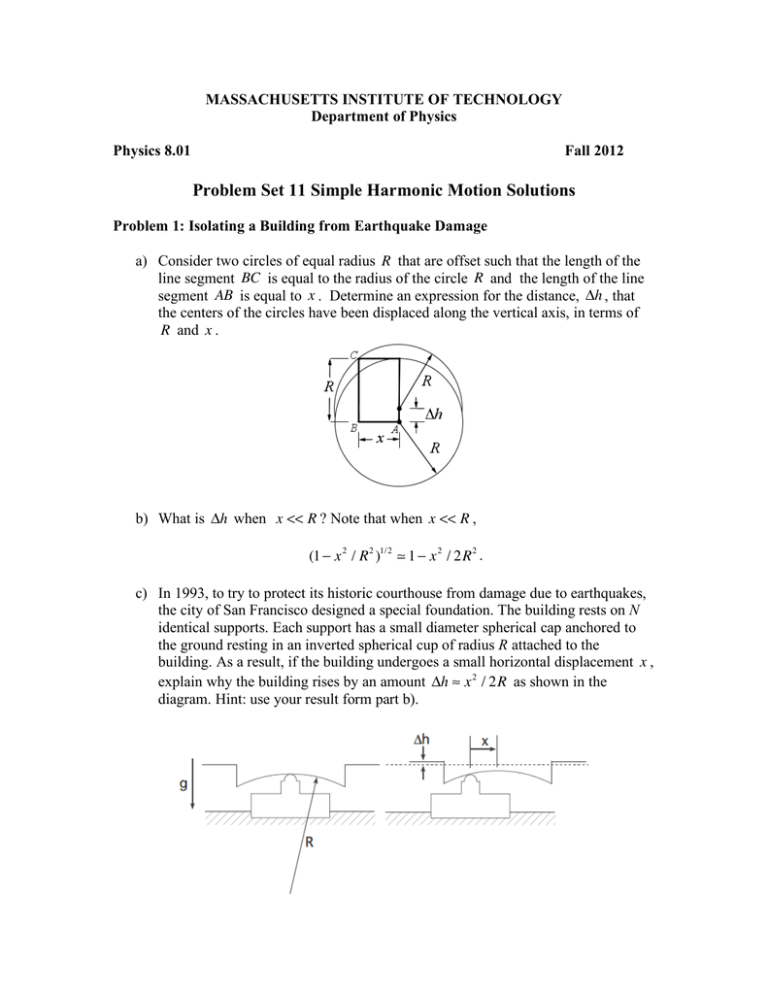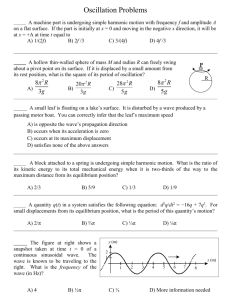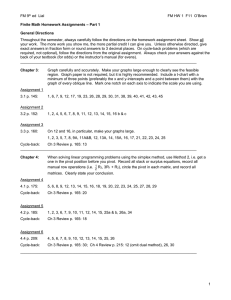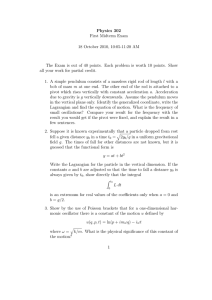Problem Set 11 Simple Harmonic Motion Solutions
advertisement

MASSACHUSETTS INSTITUTE OF TECHNOLOGY Department of Physics Physics 8.01 Fall 2012 Problem Set 11 Simple Harmonic Motion Solutions Problem 1: Isolating a Building from Earthquake Damage a) Consider two circles of equal radius R that are offset such that the length of the line segment BC is equal to the radius of the circle R and the length of the line segment AB is equal to x . Determine an expression for the distance, !h , that the centers of the circles have been displaced along the vertical axis, in terms of R and x . b) What is !h when x << R ? Note that when x << R , (1 ! x 2 / R 2 )1/2 ! 1 ! x 2 / 2R 2 . c) In 1993, to try to protect its historic courthouse from damage due to earthquakes, the city of San Francisco designed a special foundation. The building rests on N identical supports. Each support has a small diameter spherical cap anchored to the ground resting in an inverted spherical cup of radius R attached to the building. As a result, if the building undergoes a small horizontal displacement x , explain why the building rises by an amount !h " x 2 / 2R as shown in the diagram. Hint: use your result form part b). d) Assume that there is no friction. Find the differential equation which describes the dynamics of small displacements x(t) of the center of the cups from the centers of the caps. Your equation may contain as parameters some or all of the quantities N, R, the mass of the building M, and the acceleration of gravity g. e) A sudden shock sets the building moving with the initial conditions x(0) = 0 and vx (0) = v0 . Find an expression for x(t) for all subsequent times. Solution: Problem 2: Two Oscillating Springs The left side of an object of mass m is attached to a spring of spring constant k . The other side of the spring is fixed to a wall. The right side of the object is attached to a spring of spring constant 2k . The other side of the spring is fixed to a wall a distance 3l from the first wall. Both springs have equilibrium length 2l . Express your answers to the following questions in terms of m , k , and l as needed. a) When the object is in equilibrium, what is the distance, le , between the object and the left wall? b) Find the differential equation governing the horizontal displacement from the equilibrium position of the object x(t) . Assume that the block does not hit either wall. ! c) At t = 0 , the object is released at x = x0 with an initial velocity v 0 = !v0 î , v0 > 0 . Find the subsequent location of the object from equilibrium as a function of time x(t) . Solution: Problem 3 Journey to the Center of the Earth Energy Method Imagine that one drilled a hole straight through the center of the earth of mass M e and radius Re . The gravitational force on an object of mass m located inside the earth a distance r < Re from the center is due only to the mass of the earth that lies within a solid sphere of radius r . The universal gravitation constant is G . Assume the earth is of uniform mass density. a) What is the potential energy inside the earth as a function of r for the object-earth system? Can you think of a natural point to choose a zero point for the potential energy? Be careful because you will need to do a work integral to determine the change in potential energy when the object moves inside the earth and the gravitation force is no longer an inverse square when the object is inside the earth. b) Use energy considerations to find the velocity of the object when it passes through the center of the earth. c) Use energy considerations to show that the object of mass m undergoes simple harmonic motion. Solution: a) The gravitational force on an object of mass m at a distance r from the center of the Earth is given by ! Gmmenc (1) FG = ! r̂ r2 where menc is the mass enclosed in the sphere of radius r . In terms of the (uniform) mass density, 4 (2) menc = ! " r 3 . 3 The mass density is given by me (3) != (4 / 3)" re 3 And the mass enclosed is Me M er 3 3 . (4) menc = (4 / 3)! r = (4 / 3)! Re3 Re3 Therefore the gravitational force on the object of mass m when it is a distance r from the center of the earth is given by ! Gmmenc m Me FG = ! r̂ = !G r r̂ . 2 r Re3 (5) The definition of the change in potential energy between two points a distance r0 from the center of the earth with r0 < re and a distance rf from the center of the Earth with r f < re is B !U system r r f ! m Me m Me f 1 m Me 2 " = " $ Fgrav # d r = " $ "G r r̂ # dr r̂ = G r dr = G (r f " r02 ) .(6) $ 3 3 3 2 Re Re r0 Re A r0 Choose r0 = 0 as a zero reference point for the potential energy, U(r0 = 0) = 0 , and let r f = r represent any point a distance r from the center of the earth with r < re . The above change in potential energy is between these two points is then given by U (r) = 1 m Me 2 G r . 2 Re3 (7) If we release the object from rest at the surface of the earth, the initial mechanical energy is all potential energy and is given by Ei = U (re ) = Gm M e 2Re3 Re2 = Gm M e 2Re When the object reaches the center of the earth, the mechanical energy is all kinetic energy, 1 E f = K f = mvc2 . 2 (8) (9) Since there are no external forces acting on the system, there is no external work done on (or by the system), the mechanical energy is constant, Ei = E f (10) and Gm M e 2Re = 1 mv 2 . 2 c (11) The radial component of the velocity vr ,c just before the object reaches the center of the earth is then vr ,c = ! GM e Re . (12) Note we choose “just before” so that the velocity is radially inward in polar coordinates; there is no well-defined radial direction when the object is located at the origin. b) At an arbitrary time t , the energy of the object is given by E= 1 m Me 2 1 G r + mv 2 . 2 2 Re3 (13) We now set the time derivative of the energy (Eq. (13)) equal to zero 0= m M e dr dE dv =G r + mv . 3 dt dt dt Re (14) After factoring Eq. (14) becomes Me dr d 2r 0 = m (G 3 r + 2 ) . dt Re dt (15) The nontrivial solution to Eq. (15) occurs when 0=G Me Re3 r+ d 2r . dt 2 (16) This is the simple harmonic oscillator equation. If the object is released from rest at the surface of the earth, the position of the object up to the time it reaches the center of the earth (remember, the radius r cannot be negative) is given by (17) r(t) = Re cos (! 0t ) , 0 " t " T / 4 , where the angular frequency of oscillation is !0 = GM e Re3 The radial component of the velocity of the object during the same time is (18) GM e $ 2# ' $ 2# ' vr (t) = !" 0 Re sin & t) = ! sin & t . % T ( % T )( Re (19) As a check, when t = T / 4 , cos((2! / T )t) = cos(! / 2) = 0 ; hence the object is at the center of the earth. Also, sin((2! / T )t) = sin(! / 2) = 1 and the radial component of the velocity at the center of the earth is given by vr ,c = vr (T / 4) = ! in agreement with Eq. (12) GM e Re , (20) Problem 4: Oscillating and Rolling Attach a solid cylinder of mass M and radius R to a horizontal massless spring with spring constant k so that it can roll without slipping along a horizontal surface. If the system is released from rest at a position in which the spring is stretched by an amount x0 what is the find the period of simple harmonic motion for the center of mass of the cylinder? Solution: The energy of the rolling cylinder and spring system is 1 1 1 " d! % 2 E = Mvcm + I cm $ ' + kx 2 # dt & 2 2 2 2 where x is the amount of stretch or compress of the spring, I cm = is rolling without slipping 1 MR 2 ,and because it 2 d! vcm . = dt R Therefore the energy is 2 1 1 1 3 1 !v $ 2 2 E = Mvcm + MR 2 # cm & + kx 2 = Mvcm + kx 2 . " R% 2 4 2 4 2 The energy is constant so 0= dE 3 dv 1 dx 3 d2x = 2Mvcm cm + k2x = vcm ( M 2 + kx) dt 4 dt 2 dt 2 dt Because vcm is non-zero most of the time, the displacement of the spring satisfies a simple harmonic oscillator equation d 2 x 2k + x =0. dt 2 3M Hence the period is 2! 3M . T= = 2! "0 2k Problem 5 Bullet-Spring Collision A massless spring with spring constant k is attached at one end of a block of mass M that is resting on a frictionless horizontal table. The other end of the spring is fixed to a wall. A bullet of mass mb is fired into the block from the left with a speed v0 and comes to rest in the block. (Assume that this happens instantaneously). How fast is the block moving immediately after the bullet comes to rest? The resulting motion of the block and bullet is simple harmonic motion. a) Find the amplitude of the resulting simple harmonic motion. b) How long does it take the block to first return to the position x = 0 ? c) What fraction of the original kinetic energy of the bullet is stored in the harmonic oscillator? Now suppose that instead of sliding on a frictionless table during the resulting motion, the block is acted on by the spring and a weak friction force of constant magnitude f . Suppose that when the block first returned to the position x = 0 , the speed of the block was found to be one half the speed immediately after the collision that you found in part (a). d) How far did the block travel? (Your answer may include the symbol va , the speed of the block immediately after the bullet comes to rest, whether or not you have answered part (a) correctly.) Solution: The collision is completely inelastic so mbv0 = (mb + M )va (1) Thus the speed immediately after the collision is va = mb v (mb + M ) 0 (2) The energy of the spring-object system is constant since there are no external work done on the system (no fricition), therefore 1 1 2 (mb + M )va 2 = kxmax 2 2 (3) where the maximum displacement xmax = (mb + M ) va = k 1 mv k(mb + M ) b 0 (4) is the amplitude of the simple harmonic motion. Alternatively, the position of the system is given by the solution to the simple harmonic equation: x(t) = Acos ! t + Bsin ! t (5) where the angular frequency is given by != k mb + M The x-component of the velocity is given by (6) vx (t) = !" Asin " t + " B cos " t At t = 0 , x(t = 0) = A = 0 , and vx (t = 0) = ! B = B= 1 mb v0 = ! (mb + M ) (7) mb v0 , so (mb + M ) mb + M mb v0 = k (mb + M ) 1 mb v0 k(mb + M ) (8) The system reaches maximum amplitude when ! t = " / 2 . Thus from eq. (5) x(t = ! / 2" ) = Bsin(! / 2) = B = 1 mv . k(mb + M ) b 0 (9) (b) It takes the block half a period to return to the position x = 0 . The period is 2! mb + M = 2! " k (10) T ! mb + M = =! 2 " k (11) T= So the block returns to x = 0 at time t1 = c) The energy in the spring-bullet-block system is given by 2 ! mb $ 1 ! mb $ 1 1 mb 2 2 Ea = (mb + M )va = v0 2 = # m v = & # m + M & Kb b 0 2 2 (mb + M ) " mb + M % 2 " b % (12) where the kinetic energy of the bullet before the collision is 1 mbv0 2 (13) 2 So the fraction of the original kinetic energy of the bullet that is stored in the harmonic oscillator is the ratio mb / (mb + M ) . Kb = d) The work done by the friction force is given by W = ! fd (14) where d is the distance traveled by the system. This work is equal to the change in kinetic energy of the spring-bullet-block system, W = E1 ! Ea (15) The energy when the block returns to x = 0 is 2 !v $ $ 1 1 1! 1 E1 = (mb + M ) # a & = # (mb + M )va 2 & = Ea 2 4" 2 % 4 " 2% So Eq. (15) becomes ! fd = 2 % 1 3 3" 1 3 mb Ea ! Ea = ! Ea = ! $ (mb + M )va 2 ' = ! v0 2 4 4 4# 2 8 (mb + M ) & (16) (17) We can now solve for the distance traveled by the system mb2 3 d= v02 . 8 (mb + M ) f (18) Problem 6: Physical Pendulum A rigid body is composed of a uniform disk (mass m , radius R ) and a uniform rod (mass m , length D ) that is rigidly fixed to the center of the disk. This body is pivoted about the center of the disk around a horizontal axis that is perpendicular to the plane of the page. Assume the pivot is frictionless and the acceleration due to gravity is g . a) Find the moment of inertia I pivot about the pivot point. b) Suppose the pendulum is swinging freely back and forth. Write down an expression for the angular acceleration about the pivot point. You may leave your answer in terms of m , g , R , I pivot , D and the angle ! as needed. c) Suppose the angle ! is small throughout the motion. That is, you may assume sin ! " ! and cos ! " 1 . What is the period for this pendulum? Express your answer in terms of m , R , D , g and I pivot . d) Now suppose there is no restriction on the value of ! (it can be large). What is the minimum angular speed ! min that the pendulum should have at the bottom of its swing so that the pendulum can revolve completely around the pivot point? Solution: a) From the parallel axis theorem, or a handy formula sheet, the moment of inertia of the rod about the pivot point is I rod, pivot = mD 2 / 3 . The pivot is the center of the disc, so I disc, pivot = mR 2 / 2 and the total moment of inertial about the pivot is I pivot = m(R 2 / 2 + D 2 / 3) . b) The weight of the disc (and any contact force between the disc bearings and the pendulum) exert no torque, and the torque exerted by the weight of the rod, directed into the page in the figure, is ! = mg ( D / 2)sin " . The angular acceleration is then !=" # I pivot =" mg(D / 2)sin $ g sin $ , =" 2 2 2 m(R / 2 + D / 3) R / D + 2D / 3 with the negative signs indicating a restoring torque. c) The square of the frequency of small oscillations is given by the negative of the term multiplying sin ! in part (b), and so the period of small oscillations is T = 2! R2 / D + 2D / 3 . g d) Without the small angle approximation, this part of the problem cannot be solved directly by using torques; energy considerations must be use. At the bottom of the swing, 2 the kinetic energy is (1/ 2)I pivot! min and to just make it around the pivot point, the kinetic energy at the top should be taken to be zero. Note that the center of mass of the disc does not move, so in going from the bottom to the top, the change in gravitational potential energy is due only to the change in height of the center of mass of the rod and hence increased by !U = mgD . Therefore setting the change in kinetic energy equal to the negative of the change in potential energy, 1 2 I pivot!min = mgD 2 . mgD 2 gD 2 !min = = 2 I pivot R / 2 + D 2 / 3 Therefore the angular speed is ! min = 2gD . R / 2 + D2 / 3 2 (1) Problem 7 Oscillating Bar A bar of mass m and negligible height is lying horizontally across and perpendicular to a pair of counter rotating rollers as shown in the figure. The rollers are separated by a distance D . There is a coefficient of kinetic friction µ k between each roller and the bar. Assume that the bar remains horizontal and never comes off the rollers, and that its speed is always less than the surface speed of the rollers. a) Find the normal forces N L and N R exerted by the left and right rollers on the bar when the center of the bar is displaced a distance x from the position midway between the rollers. b) Find the differential equation governing the horizontal displacement of the bar x(t) . c) The bar is released from rest at x = x0 at t = 0 . Find the subsequent location of the center of the bar, x(t) . Solution: a) b) ! ! Use F = ma in the horizontal direction. Solution: Problem 8: Small Oscillations The force of interaction between a particle of mass m1 and a second particle of mass m2 separated by a distance r is given by an attractive gravitational force and a repulsive force that is proportional to r !3 , with a proportionality constant C , F (r ) = ! Gm1m2 1 +C 3 , 2 r r where C is a positive constant. a) Choose your zero point for potential energy at infinity. If the masses start off an infinite distance apart and are then moved until they are a distance r apart, what is the potential r ! ! energy difference U (r ) " U (!) = " $ F # dr ? ! b) What is the distance r0 between the two masses when they are in stable equilibrium? What is the value of the potential energy U (r0 ) at stable equilibrium? c) Calculate the angular frequency of small oscillations about the stable equilibrium position. d) For a fixed value of energy, U (r0 ) < E < 0 , find the closest distance and furthest distance between the particles.





